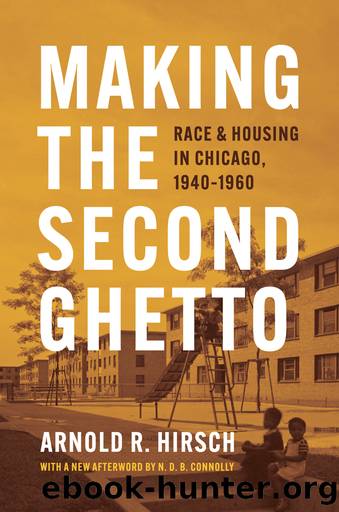Making the Second Ghetto by Arnold R. Hirsch

Author:Arnold R. Hirsch
Language: eng
Format: epub
Publisher: University of Chicago Press
Published: 2021-06-15T00:00:00+00:00
7
Making the second ghetto
You canât call Stateway [Gardens] a ghetto. It is beautiful.
Alvin Rose, executive director of the Chicago Housing Authority, U.S. Commission on Civil Rights, Hearings: Chicago (Washington, D.C.: Government Printing Office, 1959), p. 726.
[The] idiocy of Roseâs remarks is quite apparent.
Typewritten notes, n.d., Leon Despres Papers, Chicago Historical Society
In May 1953, Earl Kribben, a Marshall Field and Company vice-president, asked Governor William Stratton to make the proposed Urban Community Conservation Act an administration bill. The measure was bold in asking for powers âno mayor or alderman had ever daredâ to request and was designed to âestablish a national pattern in dealing with urban problems.â Less than eight weeks later, Kribben again wrote the governor, this time appealing for his signature on the renewal legislation that had sailed through the General Assembly. He also implored Stratton to veto a bill that provided for local referendums before public housing could be built. The passage of the latter measure, he advised, would âonly make the slum job in Chicago that much harder by effectively choking off the supply of relocation housing which must be provided if private capital is to rebuild slums.â âFurthermore,â he added, local referendums were âquite needless, as the City Council [had] the public housing site problem very well in hand.â1 The governor granted both of Kribbenâs requests.
The opponents of the renewal legislation claimed that the powers it bestowed upon the city were âunprecedentedâ encroachments upon âproperty rights and individual rights.â One critic branded the new measures âundemocraticâ and âpaternalistic,â claiming that there would be âno need for the communists to overthrow this government by force and violence because . . . the powers given in [the Urban Community Conservation Act] will enable any group of communists to do most anything they care to do.â Perhaps amused at this placement of Marshall Field and Company in the vanguard of the revolution, and supremely confident that renewal plans were well on their way to realization, Earl Kribben, when handed a copy of the criticâs remarks, simply scrawled âTsk! Tsk!â in the margin.2
This sequence of events clearly demonstrated the combination of forces that produced the second ghetto. First, the larger âdowntownâ interests and some powerful institutions situated outside the Loop found themselves confronted, after the war, with threats to their survival that were beyond even their considerable means of control. Unable to flee the city, they realized that the power of the state â not as it then existed but in greatly augmented form â would have to be enlisted in their aid. The result was that those economic and institutional interests that had the money, time, personnel, and influence to conduct surveys, make plans, draft legislation, and implement renewal did so. They exerted positive power by guiding the machinery of government. To be sure, the rhetoric of the âpublic interestâ accompanied each new legislative proposal and the wedding of private interest and public power did serve, in some instances, a broadly defined âpublic interest.â And there is no question
Download
This site does not store any files on its server. We only index and link to content provided by other sites. Please contact the content providers to delete copyright contents if any and email us, we'll remove relevant links or contents immediately.
Nudge - Improving Decisions about Health, Wealth, and Happiness by Thaler Sunstein(6644)
iGen by Jean M. Twenge(4708)
The Fire Next Time by James Baldwin(4352)
Adulting by Kelly Williams Brown(3682)
The Sports Rules Book by Human Kinetics(3597)
The Hacking of the American Mind by Robert H. Lustig(3590)
The Ethical Slut by Janet W. Hardy(3513)
Captivate by Vanessa Van Edwards(3310)
Mummy Knew by Lisa James(3176)
In a Sunburned Country by Bill Bryson(2954)
The Worm at the Core by Sheldon Solomon(2929)
Ants Among Elephants by Sujatha Gidla(2929)
Suicide: A Study in Sociology by Emile Durkheim(2617)
The Slow Fix: Solve Problems, Work Smarter, and Live Better In a World Addicted to Speed by Carl Honore(2579)
Humans of New York by Brandon Stanton(2383)
Handbook of Forensic Sociology and Psychology by Stephen J. Morewitz & Mark L. Goldstein(2380)
Blackwell Companion to Sociology, The by Judith R. Blau(2320)
The Happy Hooker by Xaviera Hollander(2277)
Outliers by Malcolm Gladwell(2263)
